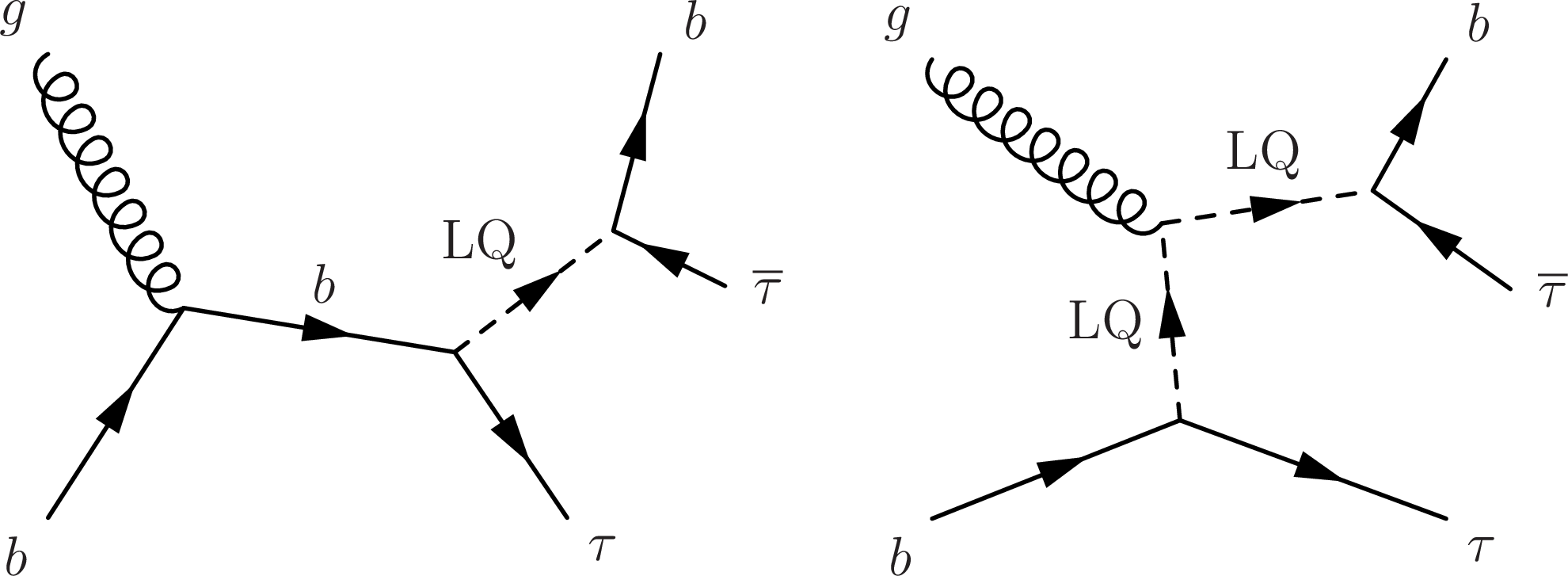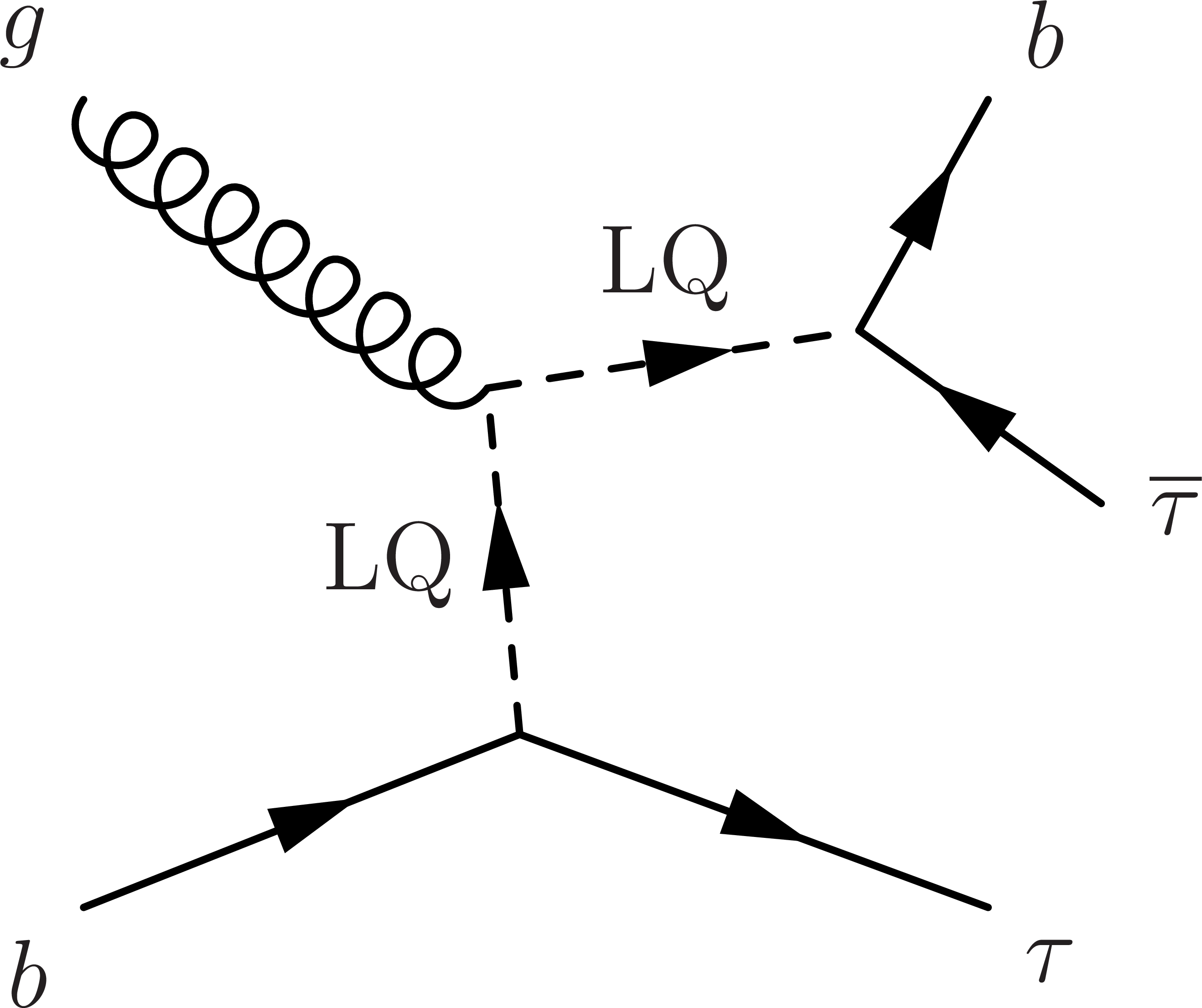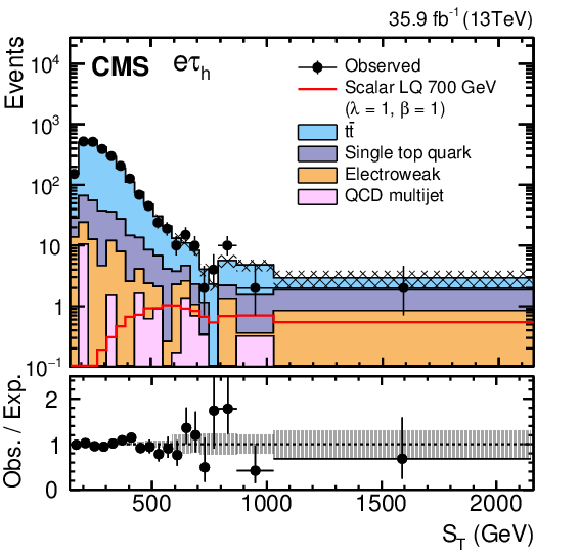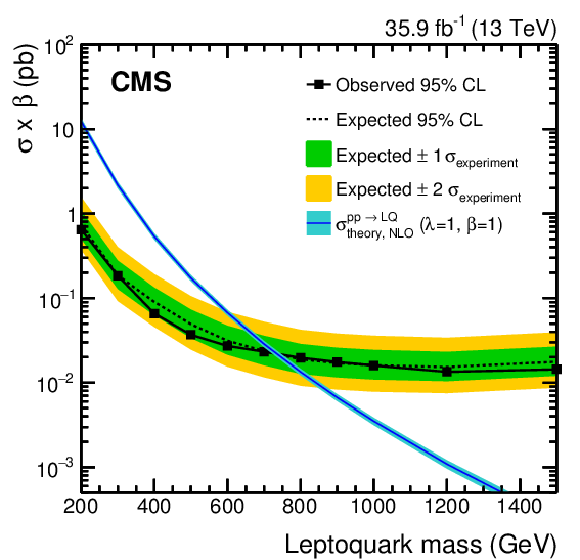

Compact Muon Solenoid
LHC, CERN
| CMS-EXO-17-029 ; CERN-EP-2018-136 | ||
| Search for a singly produced third-generation scalar leptoquark decaying to a $\tau$ lepton and a bottom quark in proton-proton collisions at $\sqrt{s} = $ 13 TeV | ||
| CMS Collaboration | ||
| 9 June 2018 | ||
| JHEP 07 (2018) 115 | ||
| Abstract: A search is presented for a singly produced third-generation scalar leptoquark decaying to a $\tau$ lepton and a bottom quark. Associated production of a leptoquark and a $\tau$ lepton is considered, leading to a final state with a bottom quark and two $\tau$ leptons. The search uses proton-proton collision data at a center-of-mass energy of 13 TeV recorded with the CMS detector, corresponding to an integrated luminosity of 35.9 fb$^{-1}$. Upper limits are set at 95% confidence level on the production cross section of the third-generation scalar leptoquarks as a function of their mass. From a comparison of the results with the theoretical predictions, a third-generation scalar leptoquark decaying to a $\tau$ lepton and a bottom quark, assuming unit Yukawa coupling ($\lambda$), is excluded for masses below 740 GeV. Limits are also set on $\lambda$ of the hypothesized leptoquark as a function of its mass. Above $\lambda = $ 1.4, this result provides the best upper limit on the mass of a third-generation scalar leptoquark decaying to a $\tau$ lepton and a bottom quark. | ||
| Links: e-print arXiv:1806.03472 [hep-ex] (PDF) ; CDS record ; inSPIRE record ; HepData record ; CADI line (restricted) ; | ||
| Figures | |

png pdf |
Figure 1:
Leading order Feynman diagrams for the single production of third-generation LQs subsequently decaying to a $\tau $ lepton and a bottom quark, for the $s$-channel (left) and $t$-channel (right) processes. |

png pdf |
Figure 1-a:
Leading order Feynman diagrams for the single production of third-generation LQs subsequently decaying to a $\tau $ lepton and a bottom quark, for the $s$-channel (left) and $t$-channel (right) processes. |

png pdf |
Figure 1-b:
Leading order Feynman diagrams for the single production of third-generation LQs subsequently decaying to a $\tau $ lepton and a bottom quark, for the $s$-channel (left) and $t$-channel (right) processes. |

png pdf |
Figure 2:
The product of acceptance, efficiency, and branching fraction as a function of $m_\text {LQ}$ for the single production of LQs in each of the three channels considered: $ {{\tau} _\mathrm {h}} {{\tau} _\mathrm {h}} $ (black solid line), $ {{\mu}} {{\tau} _\mathrm {h}} $ (red dashed line), and $ {\mathrm {e}} {{\tau} _\mathrm {h}} $ (blue dotted line). |

png pdf |
Figure 3:
Observed $S_\text {T}$ distribution in the $ {\mathrm {e}} {{\tau} _\mathrm {h}} $ (upper left), $ {{\mu}} {{\tau} _\mathrm {h}} $ (upper right), and $ {{\tau} _\mathrm {h}} {{\tau} _\mathrm {h}} $ (lower left) signal regions, as well as in the $ {\mathrm {e}} {{\mu}}$ (lower right) control region, compared to the expected SM background contributions. The distribution labeled "electroweak'' contains the contributions from W+jets, Z+jets, and diboson processes. The signal distributions for single-LQ production with mass 700 GeV are overlaid to illustrate the sensitivity. For the signal normalization, $\lambda =$ 1 and $\beta =$ 1 are assumed. The background uncertainty bands represent the sum in quadrature of statistical and systematic uncertainties obtained from the fit. The lower panels show the ratio between the observed and expected events in each bin. In all plots, the horizontal and vertical error bars on the data points represent the bin widths and the Poisson uncertainties, respectively. |

png pdf |
Figure 3-a:
Observed $S_\text {T}$ distribution |

png pdf |
Figure 3-b:
Observed $S_\text {T}$ distribution |

png pdf |
Figure 3-c:
Observed $S_\text {T}$ distribution |

png pdf |
Figure 3-d:
Observed $S_\text {T}$ distribution in the $ {\mathrm {e}} {{\mu}}$ control region, compared to the expected SM background contributions. The distribution labeled "electroweak'' contains the contributions from W+jets, Z+jets, and diboson processes. The signal distributions for single-LQ production with mass 700 GeV are overlaid to illustrate the sensitivity. For the signal normalization, $\lambda =$ 1 and $\beta =$ 1 are assumed. The background uncertainty bands represent the sum in quadrature of statistical and systematic uncertainties obtained from the fit. The lower panel shows the ratio between the observed and expected events in each bin. In all plots, the horizontal and vertical error bars on the data points represent the bin widths and the Poisson uncertainties, respectively. |

png pdf |
Figure 4:
Observed (black solid) and expected (black dotted) limits at 95% confidence level on the product of cross section $\sigma $ and branching fraction $\beta $, obtained from the combination of the $ {\mathrm {e}} {{\tau} _\mathrm {h}} $, $ {{\mu}} {{\tau} _\mathrm {h}} $, and $ {{\tau} _\mathrm {h}} {{\tau} _\mathrm {h}} $ signal regions, as well as from the $ {\mathrm {e}} {{\mu}}$ control region, as a function of the LQ mass. The green and yellow bands represent the one and two standard deviation uncertainties in the expected limits. The theory prediction is indicated by the blue solid line, together with systematic uncertainties due to the choice of PDF and renormalization and factorization scales [45], indicated by the blue band. |

png pdf |
Figure 5:
Expected and observed exclusion limits at 95% confidence level on the Yukawa coupling $\lambda $ at the LQ-lepton-quark vertex, as a function of the LQ mass. A unit branching fraction $\beta $ of the LQ to a $\tau $ lepton and a bottom quark is assumed. The red vertical line indicates the limit obtained from a search for pair-produced LQs decaying to $\ell {{\tau} _\mathrm {h}} {\mathrm {b}} {\mathrm {b}} $ [37]. The area with vertical shading shows the expected exclusion region for the present analysis. The region with diagonal blue shading shows the parameter space preferred by one of the models proposed to explain anomalies observed in B physics [36]. |
| Tables | |

png pdf |
Table 1:
Summary of systematic uncertainties in the signal acceptance and background estimate. The uncertainties have been grouped into those affecting the normalization of distributions and those affecting the shape, and uncertainties marked with a * are treated as correlated among channels. |

png pdf |
Table 2:
Numbers of events observed in the $ {\mathrm {e}} {{\tau} _\mathrm {h}} $, $ {{\mu}} {{\tau} _\mathrm {h}} $, and $ {{\tau} _\mathrm {h}} {{\tau} _\mathrm {h}} $ channels for $S_\text {T} > $ 500 GeV, compared to the background expectations and to the event yield expected for single-LQ processes with $m_\text {LQ} = $ 700 GeV ($\lambda =$ 1 and $\beta =$ 1). The "electroweak'' background contains the contributions from W+jets, Z+jets, and diboson processes. The uncertainties represent the sum in quadrature of statistical and systematic contributions, and are obtained using the binned maximum likelihood fit of the $S_\text {T}$ distribution. |
| Summary |
| A search for singly produced third-generation scalar leptoquarks, each decaying to a $\tau$ lepton and a bottom quark has been presented. The final state of an electron or muon plus one hadronically decaying $\tau$ lepton and the final state with two hadronically decaying $\tau$ leptons are explored. In all final states at least one energetic jet identified as originating from a bottom quark is required. The search is based on a data sample of proton-proton collisions at a center-of-mass energy of 13 TeV recorded by the CMS detector, corresponding to an integrated luminosity of 35.9 fb$^{-1}$. The data are found to be in agreement with the standard model predictions. Upper limits as a function of the leptoquark mass are set on the third-generation scalar leptoquark production cross section. Results are compared with theoretical predictions to obtain lower limits on the leptoquark mass. Assuming the leptoquark always decays to a $\tau$ lepton and a bottom quark with unit Yukawa coupling $\lambda = $ 1, third-generation scalar leptoquarks with mass below 740 GeV are excluded at 95% confidence level. Mass limits are also placed as a function of $\lambda$. For values of $\lambda > $ 1.4, the mass limit obtained by this analysis exceeds that of the search considering pair production and provides the best upper limit. For $\lambda = $ 2.5, leptoquarks are excluded in the mass range up to 1050 GeV. This is the first time that limits have been presented in the $\lambda$ versus mass plane, allowing the results to be considered in the preferred parameter space of models that invoke third-generation leptoquarks to explain anomalies observed in B hadron decays. These results thus demonstrate the important potential of single leptoquark production studies to complement pair production constraints on such models, as additional data become available. |
| References | ||||
| 1 | H. Georgi and S. L. Glashow | Unity of all elementary particle forces | PRL 32 (1974) 438 | |
| 2 | J. C. Pati and A. Salam | Unified lepton-hadron symmetry and a gauge theory of the basic interactions | PRD 8 (1973) 1240 | |
| 3 | J. C. Pati and A. Salam | Lepton number as the fourth color | PRD 10 (1974) 275, . [Erratum: \DOI10.1103/PhysRevD.11.703.2] | |
| 4 | H. Murayama and T. Yanagida | A viable SU(5) GUT with light leptoquark bosons | MPLA 7 (1992) 147 | |
| 5 | H. Fritzsch and P. Minkowski | Unified interactions of leptons and hadrons | Annals Phys. 93 (1975) 193 | |
| 6 | G. Senjanovic and A. Sokorac | Light leptoquarks in SO(10) | Z. Phys. C 20 (1983) 255 | |
| 7 | P. H. Frampton and B.-H. Lee | SU(15) grand unification | PRL 64 (1990) 619 | |
| 8 | P. H. Frampton and T. W. Kephart | Higgs sector and proton decay in SU(15) grand unification | PRD 42 (1990) 3892 | |
| 9 | S. Dimopoulos and L. Susskind | Mass without scalars | NPB 155 (1979) 237 | |
| 10 | S. Dimopoulos | Technicolored signatures | NPB 168 (1980) 69 | |
| 11 | E. Farhi and L. Susskind | Technicolor | PR 74 (1981) 277 | |
| 12 | B. Schrempp and F. Schrempp | Light leptoquarks | PLB 153 (1985) 101 | |
| 13 | W. Buchmuller and D. Wyler | Constraints on SU(5) type leptoquarks | PLB 177 (1986) 377 | |
| 14 | O. U. Shanker | $ \pi \ell $2, $ K \ell $3 and $ K^0 - \bar{K}^{0} $ constraints on leptoquarks and supersymmetric particles | NPB 204 (1982) 375 | |
| 15 | BaBar Collaboration | Evidence for an excess of $ \bar{B} \to D^{(*)} \tau^-\bar{\nu}_\tau $ decays | PRL 109 (2012) 101802 | 1205.5442 |
| 16 | BaBar Collaboration | Measurement of an excess of $ \bar{B} \to D^{(*)}\tau^- \bar{\nu}_\tau $ decays and implications for charged Higgs bosons | PRD 88 (2013) 072012 | 1303.0571 |
| 17 | Belle Collaboration | Observation of $ B^0 \to D^{*-} \tau^+ \nu_\tau $ decay at Belle | PRL 99 (2007) 191807 | 0706.4429 |
| 18 | Belle Collaboration | Observation of $ B^+ \to \bar{D}^{*0} \tau^+ \nu_\tau $ and evidence for $ B^+ \to \bar{D}^0 \tau^+ \nu_\tau $ at Belle | PRD 82 (2010) 072005 | 1005.2302 |
| 19 | Belle Collaboration | Measurement of the branching ratio of $ \bar{B} \to D^{(\ast)} \tau^- \bar{\nu}_\tau $ relative to $ \bar{B} \to D^{(\ast)} \ell^- \bar{\nu}_\ell $ decays with hadronic tagging at Belle | PRD 92 (2015) 072014 | 1507.03233 |
| 20 | Belle Collaboration | Measurement of the branching ratio of $ \bar{B}^0 \rightarrow D^{*+} \tau^- \bar{\nu}_{\tau} $ relative to $ \bar{B}^0 \rightarrow D^{*+} \ell^- \bar{\nu}_{\ell} $ decays with a semileptonic tagging method | PRD 94 (2016) 072007 | 1607.07923 |
| 21 | Belle Collaboration | Measurement of the $ \tau $ lepton polarization and $ R(D^*) $ in the decay $ \bar{B} \to D^* \tau^- \bar{\nu}_\tau $ | PRL 118 (2017) 211801 | 1612.00529 |
| 22 | Belle Collaboration | Measurement of the $ \tau $ lepton polarization and $ R(D^*) $ in the decay $ \bar{B} \rightarrow D^* \tau^- \bar{\nu}_\tau $ with one-prong hadronic $ \tau $ decays at Belle | PRD 97 (2018) 012004 | 1709.00129 |
| 23 | LHCb Collaboration | Measurement of the ratio of branching fractions $ \mathcal{B}(\bar{B}^0 \to D^{*+}\tau^{-}\bar{\nu}_{\tau})/\mathcal{B}(\bar{B}^0 \to D^{*+}\mu^{-}\bar{\nu}_{\mu}) $ | PRL 115 (2015) 111803 | 1506.08614 |
| 24 | B. Dumont, K. Nishiwaki, and R. Watanabe | LHC constraints and prospects for $ S_1 $ scalar leptoquark explaining the $ \bar B \to D^{(*)} \tau \bar\nu $ anomaly | PRD 94 (2016) 034001 | 1603.05248 |
| 25 | M. Tanaka and R. Watanabe | New physics in the weak interaction of $ \bar B\to D^{(*)}\tau\bar\nu $ | PRD 87 (2013) 034028 | 1212.1878 |
| 26 | Y. Sakaki, M. Tanaka, A. Tayduganov, and R. Watanabe | Testing leptoquark models in $ \bar B \to D^{(*)} \tau \bar\nu $ | PRD 88 (2013) 094012 | 1309.0301 |
| 27 | I. Dor\vsner, S. Fajfer, N. Ko\vsnik, and I. Ni\vsand\vzi\'c | Minimally flavored colored scalar in $ \bar B \to D^{(*)} \tau \bar \nu $ and the mass matrices constraints | JHEP 11 (2013) 084 | 1306.6493 |
| 28 | B. Gripaios, M. Nardecchia, and S. A. Renner | Composite leptoquarks and anomalies in $ B $-meson decays | JHEP 05 (2015) 006 | 1412.1791 |
| 29 | LHCb Collaboration | Differential branching fractions and isospin asymmetries of $ B \to K^{(*)} \mu^+ \mu^- $ decays | JHEP 06 (2014) 133 | 1403.8044 |
| 30 | LHCb Collaboration | Measurements of the S-wave fraction in $ B^{0}\rightarrow K^{+}\pi^{-}\mu^{+}\mu^{-} $ decays and the $ B^{0}\rightarrow K^{\ast}(892)^{0}\mu^{+}\mu^{-} $ differential branching fraction | JHEP 11 (2016) 047 | 1606.04731 |
| 31 | LHCb Collaboration | Angular analysis and differential branching fraction of the decay $ B^0_s\to\phi\mu^+\mu^- $ | JHEP 09 (2015) 179 | 1506.08777 |
| 32 | LHCb Collaboration | Angular analysis of the $ B^{0} \to K^{*0} \mu^{+} \mu^{-} $ decay using 3 fb$ ^{-1} $ of integrated luminosity | JHEP 02 (2016) 104 | 1512.04442 |
| 33 | LHCb Collaboration | Test of lepton universality using $ B^{+}\rightarrow K^{+}\ell^{+}\ell^{-} $ decays | PRL 113 (2014) 151601 | 1406.6482 |
| 34 | LHCb Collaboration | Test of lepton universality with $ B^{0} \rightarrow K^{*0}\ell^{+}\ell^{-} $ decays | JHEP 08 (2017) 055 | 1705.05802 |
| 35 | Belle Collaboration | Lepton-flavor-dependent angular analysis of $ B\to K^\ast \ell^+\ell^- $ | PRL 118 (2017) 111801 | 1612.05014 |
| 36 | D. Buttazzo, A. Greljo, G. Isidori, and D. Marzocca | B-physics anomalies: a guide to combined explanations | JHEP 11 (2017) 044 | 1706.07808 |
| 37 | CMS Collaboration | Search for third-generation scalar leptoquarks and heavy right-handed neutrinos in final states with two tau leptons and two jets in proton-proton collisions at $ \sqrt{s}= $ 13 TeV | JHEP 07 (2017) 121 | CMS-EXO-16-023 1703.03995 |
| 38 | Particle Data Group Collaboration | Review of particle physics | CPC 40 (2016) 100001 | |
| 39 | CMS Collaboration | Search for third-generation scalar leptoquarks decaying to a top quark and a $ \tau $ lepton at $ \sqrt{s}= $ 13 TeV | Submitted to \it EPJC | CMS-B2G-16-028 1803.02864 |
| 40 | CMS Collaboration | The CMS trigger system | JINST 12 (2017) P01020 | CMS-TRG-12-001 1609.02366 |
| 41 | CMS Collaboration | The CMS experiment at the CERN LHC | JINST 3 (2008) S08004 | CMS-00-001 |
| 42 | J. Alwall et al. | The automated computation of tree-level and next-to-leading order differential cross sections, and their matching to parton shower simulations | JHEP 07 (2014) 079 | 1405.0301 |
| 43 | I. Dor\vsner et al. | Physics of leptoquarks in precision experiments and at particle colliders | PR 641 (2016) 1 | 1603.04993 |
| 44 | T. Plehn, H. Spiesberger, M. Spira, and P. M. Zerwas | Formation and decay of scalar leptoquarks / squarks in ep collisions | Z. Phys. C 74 (1997) 611 | hep-ph/9703433 |
| 45 | I. Dor\vsner and A. Greljo | Leptoquark toolbox for precision collider studies | JHEP 05 (2018) 126 | 1801.07641 |
| 46 | J. Alwall et al. | Comparative study of various algorithms for the merging of parton showers and matrix elements in hadronic collisions | EPJC 53 (2008) 473 | 0706.2569 |
| 47 | J. M. Campbell, R. K. Ellis, and C. Williams | Vector boson pair production at the LHC | JHEP 07 (2011) 018 | 1105.0020 |
| 48 | R. Frederix and S. Frixione | Merging meets matching in MC@NLO | JHEP 12 (2012) 061 | 1209.6215 |
| 49 | P. Nason | A new method for combining NLO QCD with shower Monte Carlo algorithms | JHEP 11 (2004) 040 | hep-ph/0409146 |
| 50 | S. Frixione, P. Nason, and C. Oleari | Matching NLO QCD computations with parton shower simulations: the POWHEG method | JHEP 11 (2007) 070 | 0709.2092 |
| 51 | S. Alioli, P. Nason, C. Oleari, and E. Re | A general framework for implementing NLO calculations in shower Monte Carlo programs: the POWHEG BOX | JHEP 06 (2010) 043 | 1002.2581 |
| 52 | S. Alioli et al. | Jet pair production in POWHEG | JHEP 04 (2011) 081 | 1012.3380 |
| 53 | S. Frixione, P. Nason, and G. Ridolfi | A positive-weight next-to-leading-order Monte Carlo for heavy flavour hadroproduction | JHEP 09 (2007) 126 | 0707.3088 |
| 54 | S. Alioli, P. Nason, C. Oleari, and E. Re | NLO single-top production matched with shower in POWHEG: $ s $- and $ t $-channel contributions | JHEP 09 (2009) 111 | 0907.4076 |
| 55 | E. Re | Single-top Wt-channel production matched with parton showers using the POWHEG method | EPJC 71 (2011) 1547 | 1009.2450 |
| 56 | M. Czakon and A. Mitov | Top++: A program for the calculation of the top-pair cross-section at Hadron colliders | CPC 185 (2014) 2930 | 1112.5675 |
| 57 | T. Sjostrand et al. | An introduction to PYTHIA 8.2 | CPC 191 (2015) 159 | 1410.3012 |
| 58 | CMS Collaboration | Event generator tunes obtained from underlying event and multiparton scattering measurements | EPJC 76 (2016) 155 | CMS-GEN-14-001 1512.00815 |
| 59 | R. D. Ball et al. | Unbiased global determination of parton distributions and their uncertainties at NNLO and at LO | NPB 855 (2012) 153 | 1107.2652 |
| 60 | NNPDF Collaboration | Parton distributions for the LHC Run II | JHEP 04 (2015) 040 | 1410.8849 |
| 61 | GEANT4 Collaboration | GEANT4 --- a simulation toolkit | NIMA 506 (2003) 250 | |
| 62 | CMS Collaboration | CMS luminosity measurements for the 2016 data taking period | CMS-PAS-LUM-17-001 | CMS-PAS-LUM-17-001 |
| 63 | CMS Collaboration | Particle-flow reconstruction and global event description with the CMS detector | JINST 12 (2017) P10003 | CMS-PRF-14-001 1706.04965 |
| 64 | M. Cacciari, G. P. Salam, and G. Soyez | The anti-$ {k_{\mathrm{T}}} $ jet clustering algorithm | JHEP 04 (2008) 063 | 0802.1189 |
| 65 | M. Cacciari, G. P. Salam, and G. Soyez | FastJet user manual | EPJC 72 (2012) 1896 | 1111.6097 |
| 66 | H. Voss, A. Hocker, J. Stelzer, and F. Tegenfeldt | TMVA, the Toolkit for Multivariate Data Analysis with ROOT | in XI Int. Workshop on Advanced Computing and Analysis Techniques in Physics Research 2007 | physics/0703039 |
| 67 | CMS Collaboration | Performance of electron reconstruction and selection with the CMS detector in proton-proton collisions at $ \sqrt{s} = $ 8 TeV | JINST 10 (2015) P06005 | CMS-EGM-13-001 1502.02701 |
| 68 | CMS Collaboration | Performance of CMS muon reconstruction in pp collision events at $ \sqrt{s}= $ 7 TeV | JINST 7 (2012) P10002 | CMS-MUO-10-004 1206.4071 |
| 69 | M. Cacciari and G. P. Salam | Dispelling the $ N^{3} $ myth for the $ k_t $ jet-finder | PLB 641 (2006) 57 | hep-ph/0512210 |
| 70 | CMS Collaboration | Determination of jet energy calibration and transverse momentum resolution in CMS | JINST 6 (2011) 11002 | CMS-JME-10-011 1107.4277 |
| 71 | CMS Collaboration | Jet algorithms performance in 13 TeV data | CMS-PAS-JME-16-003 | CMS-PAS-JME-16-003 |
| 72 | CMS Collaboration | Pileup jet identification | CMS-PAS-JME-13-005 | CMS-PAS-JME-13-005 |
| 73 | CMS Collaboration | Identification of heavy-flavour jets with the CMS detector in pp collisions at 13 TeV | JINST 13 (2018) P05011 | CMS-BTV-16-002 1712.07158 |
| 74 | CMS Collaboration | Reconstruction and identification of $ \tau $ lepton decays to hadrons and $ \nu_\tau $ at CMS | JINST 11 (2016) P01019 | CMS-TAU-14-001 1510.07488 |
| 75 | CMS Collaboration | Performance of reconstruction and identification of tau leptons in their decays to hadrons and tau neutrino in LHC Run-2 | CMS-PAS-TAU-16-002 | CMS-PAS-TAU-16-002 |
| 76 | CMS Collaboration | MET performance in 8 TeV data | CMS-PAS-JME-12-002 | CMS-PAS-JME-12-002 |
| 77 | CMS Collaboration | Search for additional neutral MSSM Higgs bosons in the $ \tau\tau $ final state in proton-proton collisions at $ \sqrt{s}= $ 13 TeV | Submitted to \it JHEP | CMS-HIG-17-020 1803.06553 |
| 78 | CMS Collaboration | Measurement of the $ \mathrm{Z}\gamma^{*} \to \tau\tau $ cross section in pp collisions at $ \sqrt{s} = $ 13 TeV and validation of $ \tau $ lepton analysis techniques | Submitted to \it EPJC | CMS-HIG-15-007 1801.03535 |
| 79 | The ATLAS Collaboration, The CMS Collaboration, The LHC Higgs Combination Group | Procedure for the LHC Higgs boson search combination in Summer 2011 | CMS-NOTE-2011-005 | |
| 80 | G. Cowan, K. Cranmer, E. Gross, and O. Vitells | Asymptotic formulae for likelihood-based tests of new physics | EPJC 71 (2011) 1554 | 1007.1727 |
| 81 | T. Junk | Confidence level computation for combining searches with small statistics | NIMA 434 (1999) 435 | hep-ex/9902006 |
| 82 | A. L. Read | Presentation of search results: The CL$ _\text{s} $ technique | JPG 28 (2002) 2693 | |

|
Compact Muon Solenoid LHC, CERN |

|

|

|

|

|

|